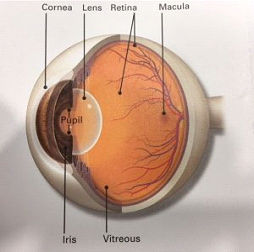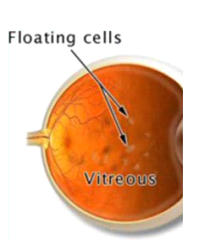Posterior Vitreous Detachment
What are floaters?

Floaters look like small specks, dots, circles, lines or cobwebs in your field of vision that move across or around your sight and may reappear and go away occasionally. While they seem to be in front of your eye, they are floating inside. You may think you see a bug or fly flying around you and may even find yourself swatting at them initially. Floaters are tiny clumps of gel or cells inside the vitreous gel of your eye and arise as the vitreous gel breaks down into a liquid. The vitreous gel sits just behind the lens of your eye and in front of your retina and comprises most of the volume in your eye. When light rays enter the eye, the light rays are focused on the retina by the lens. The light rays may encounter a floater, which then cast a shadow on your retina and hence you see a floater.
You usually notice floaters when looking at something plain, like a blank wall or a blue sky. As we age, our vitreous starts to thicken or shrink. Sometimes clumps or strands form in the vitreous. If the vitreous pulls away from the back of the eye, it is called a posterior vitreous detachment (PVD). Floaters usually happen with posterior vitreous detachment. They are not serious, and they tend to fade or go away over time. Severe floaters can be removed by surgery, but this is seldom necessary. Severe floaters may also indicate a small bleed as the process of posterior vitreous detachment (PVD) pulls too hard on a retina blood vessel and causes it to leak blood into the vitreous gel. See below about PVD.
You are more likely to get floaters if you:
- Are nearsighted (you need glasses to see far away)
- Have had surgery for cataracts
- Have had inflammation (swelling) inside the eye
What are flashes?

Flashes can look like flashing lights or lightning streaks in your field of vision. Some people compare them to seeing “stars” or small fire crackers in the sky. You might see flashes on and off for weeks, or even months. Flashes appear when the vitreous rubs, pulls/tugs on your retina.
As people age, it is common to see flashes occasionally as the process of posterior vitreous separation from the retina develops.
Other risk factors include nearsightedness, certain surgeries such as cataract surgery, infection or inflammation in the back of the eye or trauma to the eye.
What is a Posterior Vitreous Detachment?
The interior of our eye is filled with vitreous, a gel-like substance that is attached to the retina. This gel can shrink or separate, causing the vitreous membrane to detach from the retina resulting in a Posterior Vitreous Detachment.
Symptoms of Posterior Vitreous Detachment
Early warning signs of posterior vitreous detachment include:
- A sudden increase in floaters (small flecks) in the eye
- Light flashes that have been described as “a sparkle or twinkle” or “a disco light”
- Decreased vision in very rare situations
Causes of Posterior Vitreous Detachment
As a person gets older, the vitreous gel in the eye starts to shrink and can collapse causing the vitreous to detach from the retina. This is known as a posterior Vitreous Detachment. This is common in people above the age of 50, with greater risk after the age of 70.
Other risk factors include nearsightedness, certain surgeries such as cataract surgery, infection or inflammation in the back of the eye or trauma to the eye.

Treatments for Posterior Vitreous Detachment
Most people who develop a posterior vitreous detachment will not experience further complications. These patients may still experience floaters. A small number of patients with posterior vitreous detachment may develop a retina tear that may cause a Retinal Detachment.
When floaters and flashes are serious!
Most floaters and flashes are not a problem. However, there are times when they can be signs of a serious condition. You should call an ophthalmologist right away if you develop:
- A multitude of new floaters
- Lots of flashing lights
- A shadow in your side vision
- A gray curtain that covers part of your sight
These floaters and flashes could be symptoms of a torn or detached retina. This is when the retina pulls away from its underlying surface/foundation. This is a serious problem that needs to be treated.
